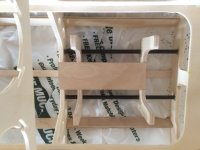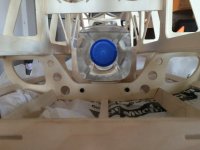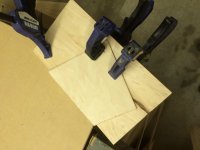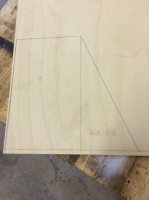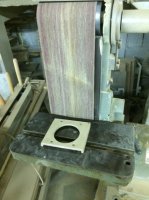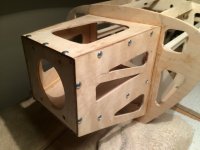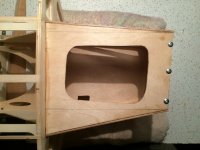The motorbox was a challenge. They supply a really cool design where the sides start with a wide base on the first bulk head and taper into a small firewall just barely big enough for the DA 100 mounting holes which come pre-drilled. The angles in the motorbox sides give both the right thrust/up thrust and the offset for the 166mm DA 100. Cool design because a smaller firewall is stronger and of course lighter than a larger square firewall built into a square motor box with the mounting holes offset. The box is made of 3 ply 3mm poplar and meant to be glassed after installation for additional strength. The firewall is about 2mm oversized in either direction to allow an angle to be sanded into the edges to match the angles of the motorbox.
Unfortunately the ZDZ 112 has too large a mounting pattern to fit on the DA 100 firewall. They supply a second firewall with a Z routered into it that happens to fit the 112 perfectly. It is also predrilled with the holes in the exact center of the firewall, not offset, so the stock motorbox can't be shortened and position it in the right place.
It might be a translation error but I think the manual says "you're a ZDZ owner, you should have no trouble with this" so I decided to try to replicate their motorbox design for the larger supplied firewall.

Measured the thrust angles and offset by measuring the the supplied motorbox and using an iphone App IHandy Level to measure the cowl to the tenth degree. The app allows you to set a flat surface as zero for a reference and then measure the cowl sitting on the table. I got 3.8 right and 1 up measuring the motobox and 4 right and 1 up measuring the cowl, so I went with 4 right 1 up.
Calculated offset using the DA 100 length of 166mm and started drawing up each side of the box.
http://www.calculator.net/triangle-calculator.html
I used this site extensively. It basically does trig without having to actually do any trig.
First I drew up the top and bottom plate and then the right and left plates as their length follows the outer edge of the top and bottom plates.
This needs to take into account a few things. The offset. The effect the angles have on length from the bulkhead to firewall. The right thrust/up thrust.
Once I had everything draw up (not remotely to scale) I transferred the plans (to exact scale) to some ultra strong 6 ply 3mm birch.
To make all the cuts I clamped various flat/jointed boards along the lines I drew and used a router to cut them with the bearing running along the board. While time consuming this is a really accurate way to make angled cuts because you have all the time in the world to get it clamped up right and once it's clamped it's almost impossible to mess up the actual cut.
I only did the tabs that connect the box to the bulkhead. I used the router to cut 6mm into the end and left tabs in place. I squared up the corners with a scroll saw and file. The main thing was to keep the edge perfectly straight on each side of the tab, I didn't worry about getting the corners perfect. The lightning holes were done on the scroll saw.
Sanded the angles into the edges of the firewall. Also sanded angles into the tab holes in the bulk head to allow the box sides to leave the bulk head at angles without snapping the tabs.
To install I first screwed the firewall to the top and bottom plate and then glued spruce rails on the edges of the top and bottom plates between the firewall and bulkhead. Then positioned the right and left plates and screwed them to the rails. Once I had everything positioned right I took it apart, applied epoxy and just put it back together. The screws aligned everything exactly how it was for the dry fit.
I may pull the screws from the sides which are not directly holding the firewall on. They look cool, but they're not providing any strength...they were just needed for alignment/assembly.
It probably ended up a little heavier than stock even without glassing, but it's extremely strong. The birch ply is much stronger and the spruce rails will really hold it all together.


